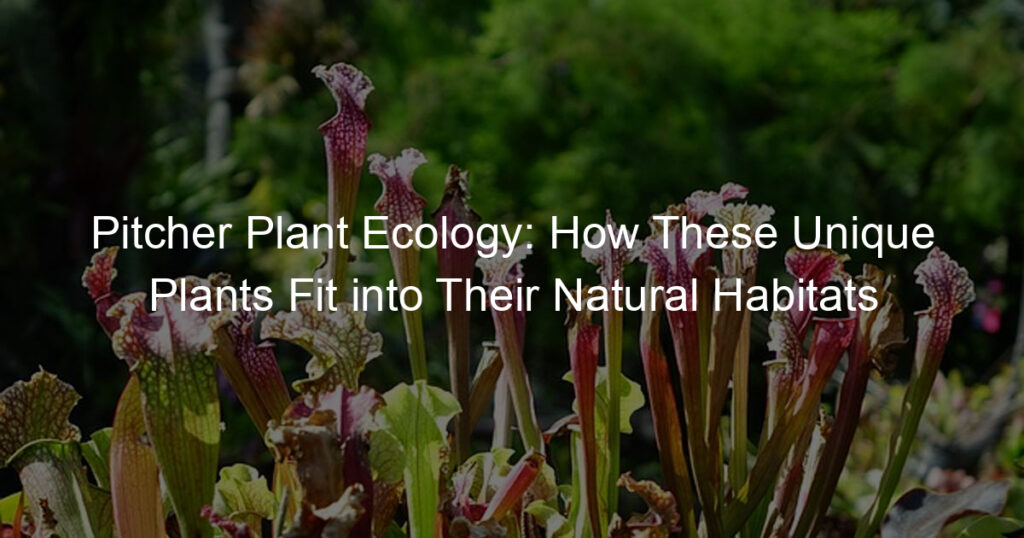Pitcher plants are an incredibly unique family of flowering carnivorous plants, with over 130 species throughout the world. It’s hard to miss why these beautiful, sometimes brightly-colored creatures have a captivating effect on people—they look like something from another planet!
Where do pitcher plants grow naturally?
Pitcher plants are fascinating specimens of nature that have adapted to exist in many different habitats. Native to the southern and eastern United States, pitcher plants grow naturally along swampy areas of the Atlantic Coast from North Carolina down to Florida.
These carnivorous plants also populate in bogs throughout Canada and can be found along riverbanks, ponds, and ditches in Puerto Rico. While pitcher plants thrive in warm and wet climates, some varieties also grow further north into regions with cooler temperatures.
Overall, it is estimated that there are over 80 species of pitcher plants living across bogs, marshes, and other low-nutrient environments around the world!
What is the role of pitcher plants in their ecosystem?
Pitcher plants are amazing species that play an important role in their ecosystem. Not only do they provide protection and shelter to many other creatures, but they also have even bigger roles.
Pitcher plants feed by trapping and digesting insects within the “pitchers” of their leaves, providing important nutrients to the local environment. On top of that, these carnivorous plants can help keep insect populations under control since they cannot move around as most predators do. Overall, pitcher plants are a vital part of any healthy ecosystem!
How do pitcher plants obtain nutrients?
Pitcher plants are a type of carnivorous plants known for their unique method of obtaining nutrients. They capture and digest small animals using a distinctive pitcher-shaped leaf that acts like a trap.
Inside the pitcher, they produce digestive enzymes which break down prey, absorbing essential nutrients such as nitrogen and phosphorus. This arrangement allows them to supplement their food intake and thrive in nutrient-poor environments.
In addition, their advanced trapping strategies ensure they obtain adequate nutrition while avoiding larger predators that may eat them instead. It’s an impressively effective adaptation that has ensured this remarkable species has been cultivated by botanists around the world for centuries!
What animals rely on pitcher plants?
The amazing pitcher plant is more than just an attractive feature in a rainforest – it’s a sanctuary and source of sustenance for many animals. Creatures such as the crab spider and certain species of moth use the pitcher plants to both hunt their prey and also to hide from potential predators.
Even tadpoles can find refuge in these slippery pits, taking advantage of the nutrient-rich broth within them for nourishment. Although it may not look like much at first glance, this small plant plays a crucial role in sustaining rainforest life.
How do pitcher plants adapt to their environment?
Pitcher plants are fascinating creatures that have developed special adaptations to cope with the difficult environment they live in. Many pitcher plant species inhabit nutrient-poor acidic soils and grow their pitchers directly from the soil surface, allowing them to harvest more nutrients from rainwater.
These pitchers are filled with a digestive liquid that accumulates various nutrients as well as other organisms, such as insects, which are broken down for additional nutrition. These plants also possess a waterproof waxy cuticle on the outside of their leaves and highly specialized opening structures that allow them to collect a greater volume of water and sunshine than other plants.
As if these adaptations weren’t impressive enough, pitcher plants can use several defensive techniques when detecting unwelcome insect visitors, like raising their pitchers or secreting sticky drops onto the walls of their leaves. This helps them make sure they get enough nutrition without having to compete with other organisms in their environment.
What threats do pitcher plants face?
Pitcher plants are quite fascinating, as they’re known for their unique hunting technique and appearance. However, like almost everything else in nature, they’re not immune to being threatened by certain factors.
The biggest threats pitcher plants face come from human activity: when humans engage in activities that contribute to climate change and deforestation, it has negative consequences for pitcher plants and their environment.
Another big threat is pollution caused by fertilizers and herbicides – both of these can cause the soil around the pitcher plant to become nutrient-deficient or even destructive to it. These threats add up, making pitcher plants increasingly vulnerable over time unless people take steps to protect them.
Conclusion
The pitcher plant is a fascinating species, capable of surviving and thriving in many different environments. It has long been a source of fascination for scientists, collectors, and hobbyists alike. Its capabilities and adaptations have enabled it to become an integral part of its ecosystems, providing food as well as contributing to the biogeochemistry of its environment.








